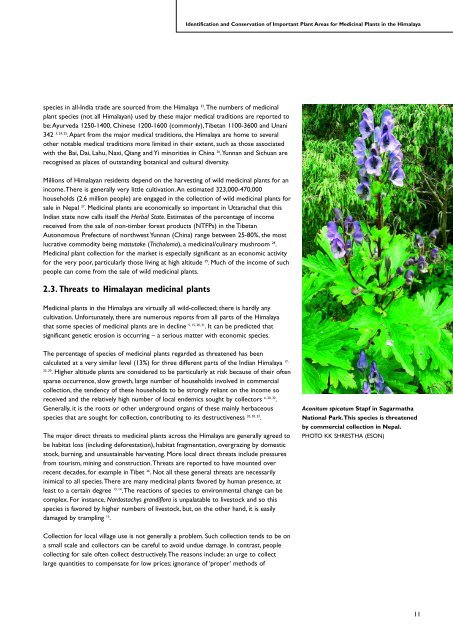Identification and Conservation of Important Plant Areas - Plantlife
Identification and Conservation of Important Plant Areas - Plantlife
Identification and Conservation of Important Plant Areas - Plantlife
- No tags were found...
You also want an ePaper? Increase the reach of your titles
YUMPU automatically turns print PDFs into web optimized ePapers that Google loves.
<strong>Identification</strong> <strong>and</strong> <strong>Conservation</strong> <strong>of</strong> <strong>Important</strong> <strong>Plant</strong> <strong>Areas</strong> for Medicinal <strong>Plant</strong>s in the Himalayaspecies in all-India trade are sourced from the Himalaya 23 .The numbers <strong>of</strong> medicinalplant species (not all Himalayan) used by these major medical traditions are reported tobe:Ayurveda 1250-1400, Chinese 1200-1600 (commonly),Tibetan 1100-3600 <strong>and</strong> Unani342 3, 24, 25 .Apart from the major medical traditions, the Himalaya are home to severalother notable medical traditions more limited in their extent, such as those associatedwith the Bai, Dai, Lahu, Naxi, Qiang <strong>and</strong> Yi minorities in China 26 .Yunnan <strong>and</strong> Sichuan arerecognised as places <strong>of</strong> outst<strong>and</strong>ing botanical <strong>and</strong> cultural diversity.Millions <strong>of</strong> Himalayan residents depend on the harvesting <strong>of</strong> wild medicinal plants for anincome.There is generally very little cultivation.An estimated 323,000-470,000households (2.6 million people) are engaged in the collection <strong>of</strong> wild medicinal plants forsale in Nepal 27 . Medicinal plants are economically so important in Uttarachal that thisIndian state now calls itself the Herbal State. Estimates <strong>of</strong> the percentage <strong>of</strong> incomereceived from the sale <strong>of</strong> non-timber forest products (NTFPs) in the TibetanAutonomous Prefecture <strong>of</strong> northwest Yunnan (China) range between 25-80%, the mostlucrative commodity being mastutake (Tricholoma), a medicinal/culinary mushroom 28 .Medicinal plant collection for the market is especially significant as an economic activityfor the very poor, particularly those living at high altitude 29 . Much <strong>of</strong> the income <strong>of</strong> suchpeople can come from the sale <strong>of</strong> wild medicinal plants.2.3. Threats to Himalayan medicinal plantsMedicinal plants in the Himalaya are virtually all wild-collected; there is hardly anycultivation. Unfortunately, there are numerous reports from all parts <strong>of</strong> the Himalayathat some species <strong>of</strong> medicinal plants are in decline 5, 15, 30, 31 . It can be predicted thatsignificant genetic erosion is occurring – a serious matter with economic species.The percentage <strong>of</strong> species <strong>of</strong> medicinal plants regarded as threatened has beencalculated at a very similar level (13%) for three different parts <strong>of</strong> the Indian Himalaya 17,22, 30. Higher altitude plants are considered to be particularly at risk because <strong>of</strong> their <strong>of</strong>tensparse occurrence, slow growth, large number <strong>of</strong> households involved in commercialcollection, the tendency <strong>of</strong> these households to be strongly reliant on the income soreceived <strong>and</strong> the relatively high number <strong>of</strong> local endemics sought by collectors 6, 30, 32 .Generally, it is the roots or other underground organs <strong>of</strong> these mainly herbaceousspecies that are sought for collection, contributing to its destructiveness 20, 30, 33 .The major direct threats to medicinal plants across the Himalaya are generally agreed tobe habitat loss (including deforestation), habitat fragmentation, overgrazing by domesticstock, burning, <strong>and</strong> unsustainable harvesting. More local direct threats include pressuresfrom tourism, mining <strong>and</strong> construction.Threats are reported to have mounted overrecent decades, for example in Tibet 26 . Not all these general threats are necessarilyinimical to all species.There are many medicinal plants favored by human presence, atleast to a certain degree 13, 14 .The reactions <strong>of</strong> species to environmental change can becomplex. For instance, Nardostachys gr<strong>and</strong>iflora is unpalatable to livestock <strong>and</strong> so thisspecies is favored by higher numbers <strong>of</strong> livestock, but, on the other h<strong>and</strong>, it is easilydamaged by trampling 15 .Aconitum spicatum Stapf in SagarmathaNational Park.This species is threatenedby commercial collection in Nepal.PHOTO KK SHRESTHA (ESON)Collection for local village use is not generally a problem. Such collection tends to be ona small scale <strong>and</strong> collectors can be careful to avoid undue damage. In contrast, peoplecollecting for sale <strong>of</strong>ten collect destructively.The reasons include: an urge to collectlarge quantities to compensate for low prices; ignorance <strong>of</strong> ‘proper’ methods <strong>of</strong>11
















